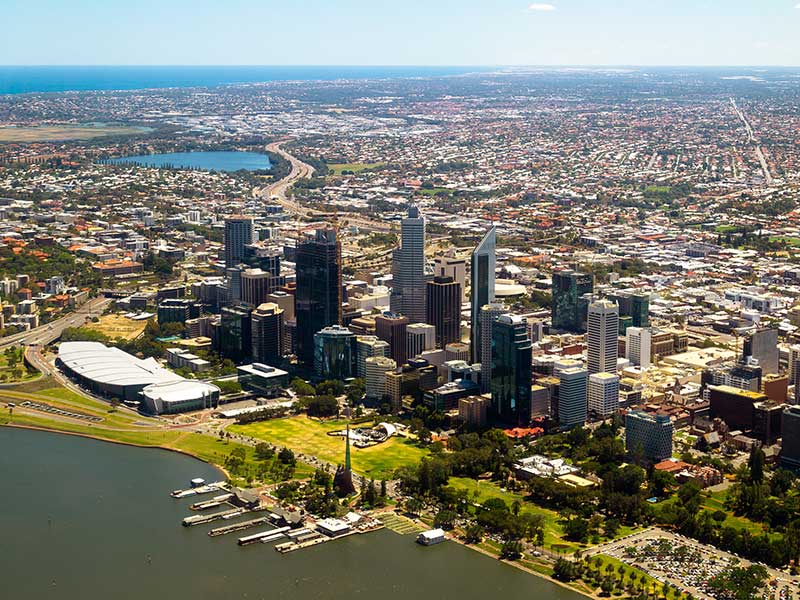All state-owned coal-fired power stations in Western Australia will close by 2030 as the state government launches a new green industry transition fund and commits the state-owned energy company to a multi-billion-dollar green infrastructure campaign.
Electricity retailer and generator Synergy will invest an estimated $3.8 billion by 2030 to build green energy infrastructure, including wind farms and battery storage connected to the South-West Interconnected System, the state’s main grid. The money will also fund feasibility studies into pumped hydro and hydrogen projects. Accompanying this is an additional $547.4 million to support the transition of the economy of Collie, which is currently the state’s coal centre.
Renewable energy infrastructure will need to compensate for the closure of coal-fired Collie Power Station in late-2027 and the final stage of Muja power station in late-2029, both located near Collie. Muja power station has been undergoing a staggered shutdown since 2019. Collie Power Station has a capacity of 350MW while Muja has a capacity of 1094MW.

Western Australian Premier and Treasurer Mark McGowan said the government was embarking on one of the biggest infrastructure projects in the state’s history.
“The reality is our current electricity system is becoming increasingly unsustainable due to the uptake of rooftop solar and growing demand for renewable options for generation,” Mr McGowan said.
“This investment makes economic sense, as it pays for itself by 2030-31, instead of continuing to pay increasing subsidies under the status quo. Western Australia will implement a sensible, managed transition to a greater use of renewables for electricity generation, while ensuring we maintain electricity reliability as a priority.”
According to the state government, Synergy would require $3 billion of subsidies until 2029-30 to mitigate electricity price hikes if no changes are made. Household electricity costs would rise from $1,800 to more than $3,000 given the state’s current electricity arrangement.
Large uptakes of rooftop solar have meant Synergy must offload excess energy during the day, at cost. Earlier this year, it was announced that the amount of energy produced from rooftop solar in Western Australia had surpassed the capacity of Muja power station. Currently, one in three homes has rooftop solar with that figure expected to rise to half of all homes by 2030.
Energy Minister Bill Johnston noted the pressure on the grid caused by solar uptake and reaffirmed the government’s commitment to securing the economy of Collie.
“The amount of rooftop solar coming online currently in WA is roughly the equivalent of adding a new coal-fired generation unit every year. This is putting unprecedented pressure on the system and we must act to keep costs as low as possible, while transitioning to higher levels of renewables and storage,” Mr Johnston said.
“Our government is squarely focused on making sure there continues to be high quality, well-paid local jobs in the kinds of heavy industries the Collie region is known for. The town’s location, existing power infrastructure and skilled local workforce means it will remain central to the State’s energy generation efforts.”
Of the $547.4 million added to the Collie Transition Package, $200 million is being set aside for the Collie Industrial Transition Fund. This will target emerging industries such as battery manufacturing, wind turbine manufacturing, hydrogen, green cement, and minerals processing as well as supporting infrastructure.
There will also be an additional $2 million added to the Collie Futures Small Grants Program and $21 million to expand the Collie Jobs and Skills Centre. This includes the creation of a Collie Future Curriculum Fund for industry-specific skills training. In particular, workers impacted by the economic transition can access free training if they want to complete a full qualification or short course.
Also included is a $300 million investment for coordinated decommissioning works of the Collie and Muja Power Stations after they close. The remaining $38 million is to support tourism amenities and projects.
Further support to transition Collie’s economy adds to the $115 million already committed across several schemes, including the $20 million Collie Futures Fund and the ongoing Just Transition Plan. A feasibility study is currently underway to construct the state’s largest big battery in Collie.
Member for the Western Australian Legislative Assembly for Collie-Preston Jodie Hanns acknowledged that the coal power station closure announcements made it “a tough day for our community”, given the town’s economic history, but one that was accompanied with “important opportunity”.
“Since 2017 we have been planning and preparing for this transition and that early work will prove invaluable as we move into this next phase. We have a solid plan to do this, with the workforce and our community at the heart of everything we are doing,” Ms Hanns said.
“I want Collie to be held up as an example to other communities around the world facing these kinds of challenges – to show how this can be done right, support the impacted workforce, and ensure a long, prosperous jobs future for the town.”
Do you know more? Contact James Riley via Email.

